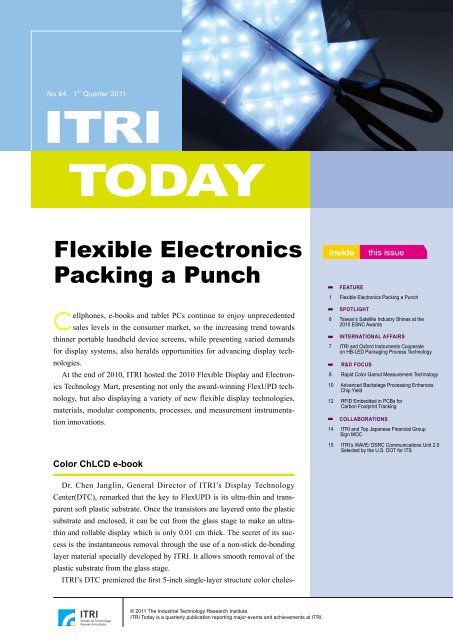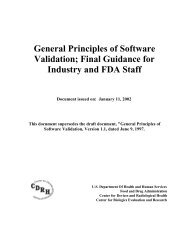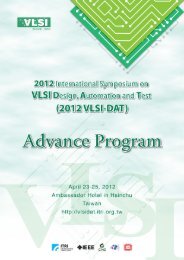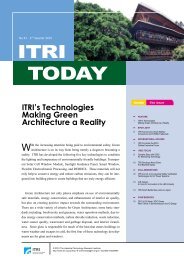ITRI TODAY
ITRI TODAY
ITRI TODAY
- No tags were found...
You also want an ePaper? Increase the reach of your titles
YUMPU automatically turns print PDFs into web optimized ePapers that Google loves.
No 64. 1 st Quarter 2011<br />
<strong>ITRI</strong><br />
<strong>TODAY</strong><br />
Flexible Electronics<br />
Packing a Punch<br />
Cellphones, e-books and tablet PCs continue to enjoy unprecedented<br />
sales levels in the consumer market, so the increasing trend towards<br />
thinner portable handheld device screens, while presenting varied demands<br />
for display systems, also heralds opportunities for advancing display technologies.<br />
At the end of 2010, <strong>ITRI</strong> hosted the 2010 Flexible Display and Electronics<br />
Technology Mart, presenting not only the award-winning FlexUPD technology,<br />
but also displaying a variety of new flexible display technologies,<br />
materials, modular components, processes, and measurement instrumentation<br />
innovations.<br />
Color ChLCD e-book<br />
Inside<br />
FEATURE<br />
1 Flexible Electronics Packing a Punch<br />
SPOTLIGHT<br />
this issue<br />
6 Taiwan’s Satellite Industry Shines at the<br />
2010 ESNC Awards<br />
INTERNATIONAL AFFAIRS<br />
7 <strong>ITRI</strong> and Oxford Instruments Cooperate<br />
on HB-LED Packaging Process Technology<br />
R&D FOCUS<br />
8 Rapid Color Gamut Measurement Technology<br />
10 Advanced Backstage Processing Enhances<br />
Chip Yield<br />
12 RFID Embedded in PCBs for<br />
Carbon Footprint Tracking<br />
COLLABORATIONS<br />
14 <strong>ITRI</strong> and Top Japanese Financial Group<br />
Sign MOC<br />
15 <strong>ITRI</strong>’s WAVE/ DSRC Communications Unit 2.0<br />
Selected by the U.S. DOT for ITS<br />
Dr. Chen Janglin, General Director of <strong>ITRI</strong>’s Display Technology<br />
Center(DTC), remarked that the key to FlexUPD is its ultra-thin and transparent<br />
soft plastic substrate. Once the transistors are layered onto the plastic<br />
substrate and enclosed, it can be cut from the glass stage to make an ultrathin<br />
and rollable display which is only 0.01 cm thick. The secret of its success<br />
is the instantaneous removal through the use of a non-stick de-bonding<br />
layer material specially developed by <strong>ITRI</strong>. It allows smooth removal of the<br />
plastic substrate from the glass stage.<br />
<strong>ITRI</strong>’s DTC premiered the first 5-inch single-layer structure color choles-<br />
<strong>ITRI</strong> <strong>TODAY</strong><br />
▂<br />
SPRING Quarter 2011<br />
▂<br />
1<br />
© 2011 The Industrial Technology Research Institute.<br />
<strong>ITRI</strong> Today is a quarterly publication reporting major events and achievements at <strong>ITRI</strong>.
FEATURE<br />
Color ChLCD offers a 50 Hz refresh rate and 10 to 20<br />
screen updates a second, more than 10 times faster than<br />
traditional passive ChLCD or EPD systems.<br />
Source:<strong>ITRI</strong><br />
teric liquid crystal display (ChLCD), produced in conjunction<br />
with display makers providing the TFT active<br />
substrate. It is an Active Matrix color ChLCD which<br />
offers a 50 Hz refresh rate and 10 to 20 screen updates<br />
a second, more than 10 times faster than traditional passive<br />
ChLCD or electrophoretic display (EPD) systems.<br />
The ChLCD manufacturing processes are very compatible<br />
with the traditional TFT LCD processes, and as we<br />
move towards active color ChLCD driver development,<br />
in addition to e-book applications, these displays will be<br />
highly suited for the use in tablet PCs and iPads.<br />
ChLCD-e-Signage<br />
The exhibit also featured ChLCD e-Signage, which requires only 80V to drive<br />
the image change process, and allows adaptable color change in any area, unlike<br />
in the past where only limited regional color display potential existed. While<br />
prior A-4 size images required a full minute to update, the new display updates<br />
completely in only thirty seconds.<br />
Besides the prior 5 inch displays, it is now possible to use splicing techniques<br />
to generate A-4 size, with system thickness of less than 1 cm, and power requirements<br />
small enough that a battery is sufficient to drive operations.<br />
Green Self-Powered<br />
Window Modulator<br />
A-4 sized ChLCD-e-Signage with<br />
system thickness of less than<br />
1 cm, and power requirements<br />
small enough that a battery is sufficient<br />
to drive operations.<br />
Source:<strong>ITRI</strong><br />
<strong>ITRI</strong> <strong>TODAY</strong><br />
▂<br />
SPRING Quarter 2011<br />
▂<br />
2<br />
Green Self-Powered Window<br />
Modulator uses EWD display<br />
technology that allows a very<br />
low driving voltage requirement,<br />
higher driver speed, and more<br />
color selectivity.<br />
Source:<strong>ITRI</strong><br />
The Green Self-Powered Window Modulator has significant advantages over<br />
polymer conditioning dispersed liquid crystal (PDLC) smart window technologies,<br />
in that the EWD display has a very low driving voltage requirement of 10V.<br />
Moreover, the driver speed, color selectivity and other specifications are highly<br />
competitive for smart window technologies.<br />
This technology allows for modular shutters to serve as energy-saving smart<br />
windows. Its lack of any field of vision limitations means that unobstructed views<br />
are possible even in bright lighting. Electrode changes permit display modulation<br />
that ensures adaptability for applications such as large department store windows,<br />
and its long-term use can achieve even better energy-saving results.
Cut it Into Any Shape!<br />
<strong>ITRI</strong>’s Electronics and Optoelectronics<br />
Research Labs (EOL) has developed electro-optical<br />
substrate and FlexLite technologies,<br />
which rely on soft silicone packaging<br />
technology and circuit design to create a<br />
completely new flexible lighting technology<br />
with a thickness of only 0.5 cm.<br />
There are two core technologies involved.<br />
First, the LED is a light source which emits The FlexLite is not only an illuminant material, but can be used in any contexual<br />
format.<br />
heat, requiring a high thermal conductivity<br />
Source:<strong>ITRI</strong><br />
structure, so <strong>ITRI</strong> added graphene structure<br />
technologies to the back of the light, allowing<br />
generation of high thermal conductivity with concomitant deflection effects. Secondly, in the front of the lamp housing,<br />
an optical absorption structure was adopted, allowing the use of a flexible honeycomb structural design or tangram<br />
structure, to achieve uniform effects without disruptive glare.<br />
With the FlexLite, designers can sculpt any lighting forms they desire, and any soft light source applied to the design<br />
can be used, ensuring unlimited innovative potential for professional lighting designers.<br />
R2R Manufacturing of<br />
Large Area Touch Panels<br />
Division of Flexible Electronics Technology of <strong>ITRI</strong><br />
EOL has developed the world’s first R2R Manufacturing<br />
of Single Substrate Direct Bridging Projective Capacitive<br />
Touch Panel, including full integration of materials, equipment<br />
and processes. Through the key R2R processes,<br />
previous single sheet production of digital resistive touch<br />
panels can advance to much larger sizes no longer limited<br />
by the sheet type area. Using current 3.5 inch touch<br />
screens as initial verification tools, we can expect that the<br />
R2R Manufacturing of Large Area Touch Panels may help<br />
critical R2R processes will allow future developments of<br />
Taiwan industries to achieve an integrated flexible electronics<br />
touch panel supply chain.<br />
touch panels larger than 20 to 30 inches.<br />
Source:<strong>ITRI</strong><br />
Following the establishment of the Flexible Electronics<br />
Touch Panel R&D Alliance, Taiwan has begun to achieve<br />
an integrated flexible electronics touch panel supply chain, and it is expected that by 2014 there will be four touch panel<br />
production lines yielding an estimated annual US$100 million in output.<br />
<strong>ITRI</strong> <strong>TODAY</strong><br />
▂<br />
SPRING Quarter 2011<br />
▂<br />
3
FEATURE<br />
Inorganic/organic Hybrid Substrate<br />
for Flexible AM<br />
<strong>ITRI</strong>’s FlexUPD (Flexible Universal Plane for Displays) was<br />
specially developed to allow panel makers to convert their existing<br />
production lines and processes for glass panels to the manufacture<br />
of flexible displays with minimal investment in new equipment.<br />
FlexUPD is used between a polymer film and glass carrier, with<br />
layered coating material, so that when the production process is Combined with the polymer film, glass carrier and<br />
layered coating material, the layer of the panel’s<br />
complete, the layer of the panel’s requisite thin film transistor arrays<br />
can be easily removed from the glass substrate without dam-<br />
requisite thin film transistor arrays can be easily<br />
removed from the glass substrate.<br />
Source:<strong>ITRI</strong><br />
age to the transistors.<br />
Agglomerated from layered high content silica/polyimide composites,<br />
with concomitant low forming stress and high heat-resistance, high dimensional stability, high transparency, high<br />
flatness, and good bending characteristics, it is highly suitable for applications in production processes for most types of<br />
flexible plastic displays, including LCD, OLED, PDP, FED, SED, E-link, and E-paper.<br />
The innovative FlexUPD technology has achieved global recognition, having been honored as both the Wall Street<br />
Journal’s 2010 TIA Gold Winner and R&D Magazine’s R&D 100 Awards. It will assist panel makers to build on their existing<br />
glass manufacturing advantages as they branch out into producing flexible high-end display or e-book products.<br />
E-paper Display Quality Inspection<br />
<strong>ITRI</strong> <strong>TODAY</strong><br />
▂<br />
SPRING Quarter 2011<br />
▂<br />
4<br />
<strong>ITRI</strong>’s E-paper Display Quality Inspection includes<br />
a high stability light source, with uniform luminescence<br />
design, and high-sensitivity CCDs, deploying special<br />
enhancement algorithms for precise calibrations, ensuring<br />
suitability not only for comprehensive E-paper<br />
display quality evaluation, but also for LCD panel<br />
measurements. The system adapts CCD and backlight<br />
sources to proportionally measure e-paper reflectance:<br />
color coordinates are determined through four color<br />
Through <strong>ITRI</strong>’ s E-paper Display Quality Inspection system,<br />
filters, deploying CIE curvature, and ensuring proper the low contrast blur phenomenon can be detected and the<br />
causes elucidated so that processes can be fine tuned.<br />
identification of panel color accuracy for use in further<br />
Source:<strong>ITRI</strong><br />
future process improvements.<br />
Additionally, <strong>ITRI</strong>’s Center for Measurement Standards<br />
(CMS) explains that when e-paper is engaged in video switching, there is often a blurred residual ghost image<br />
from the prior display, and with grayscale image quality and contrast-to-noise ratios of 1:1, they are difficult to detect.<br />
But with this complete system, the low contrast blur phenomenon can be detected and the causes elucidated so<br />
that processes can be fine tuned. Moreover, in regard to color coordinates, we can expect further filtering improvements<br />
to allow greater precision.
Panel Industry Integration<br />
2010 has been a crucial year for the global panel<br />
industry. The financial tsunami affected not only consumer<br />
markets, panel makers, machine foundries, and<br />
brand factories, but also caused material changes in<br />
circumstances for the entire industry. <strong>ITRI</strong>’s Industrial<br />
Economics and Knowledge Center (IEK) notes three<br />
interesting phenomena affecting the panel industry.<br />
First, there were the post-financial tsunami effects<br />
on machine foundries with less end-market demand,<br />
resulting in weaker upstream panel demand forecasting,<br />
causing supply chain imbalances and supply-demand<br />
instability, such that upstream and downstream networks<br />
had to cooperate to establish more stable supply<br />
relationships. This reshuffling has favored the larger<br />
players.<br />
Secondly, in order to create higher value, the panel<br />
industry moved towards diversified development, and<br />
vertical integration among upstream and downstream<br />
supplier networks, with panel makers integrating their<br />
downstream to enjoy better control, while foundries<br />
also sought to enhance upstream integration to stabilize<br />
their supply sources.<br />
Thirdly, there was the rapid rise of the foundry industry,<br />
not only in terms of the industry itself, but through<br />
directly engaging distribution networks. For example,<br />
the wholly integrated foundry business of Foxconn<br />
Electronics in China established cooperation with the<br />
fifth largest global distributor Metro to jointly open<br />
stores. Whether this collaborative model will prove successful<br />
remains to be seen.<br />
The success of Amazon’s Kindle and Apple’s iPad<br />
has further established the trend towards e-books and<br />
digital publishing. The current slate of e-book readers<br />
are mainly three types: bistable (EPD and cholesteroltype<br />
liquid crystal gel electrophoresis), electrowetting<br />
(EWD) MEMS display, and notebook computers, tablet<br />
PCs, and mobile phones. Market trends are in the direction<br />
of large-size, lower-priced, touch screen, color, and<br />
flexible displays.<br />
Vanguard technologies including<br />
flexible substrate e-paper, color<br />
e-paper, and built-in touch capable<br />
e-paper displays, are all likely to<br />
remain the focus of the market’s<br />
attention in 2011.<br />
Looking ahead to 2011, <strong>ITRI</strong>’s IEK emphasizes that<br />
Taiwan’s small and medium-sized panel industry is undergoing<br />
transformation. It is seen much new capacity,<br />
and continued vertical and horizontal market arrangements<br />
among panel makers in 2010, resulting in three<br />
major changes: LCD panel makers acquiring touch<br />
panel production lines, large demand for flat panel touch<br />
products resulting in reshuffling among the major players,<br />
and touch panel makers forming group corporations.<br />
Expansion by Chinese companies, and investments in<br />
high technology or niche market products by Japanese<br />
and Korean makers ensures greater volatility among the<br />
entire small and medium sized panel industry.<br />
In terms of the three core technologies, the TFT-LCD<br />
industry continues to enjoy breakthroughs, with four<br />
trends to watch: the revolutionary impacts posed by<br />
new materials like Oxide TFT, the expanding demand<br />
for wide angle viewing resulting from the success of the<br />
iPad, the iPhone4 demanding high resolution, as well as<br />
environmental stewardship and green energy concerns.<br />
OLEDs are moving towards full functionality including<br />
touch functions, 3D naked eye, AR, new pixel integration<br />
and flexible applications.<br />
Vanguard technologies including flexible substrate e-<br />
paper, color e-paper, and built-in touch capable e-paper<br />
displays, are all likely to remain the focus of the market’s<br />
attention in 2011, with the triple threat of touch<br />
technology, 3D technology and flexible display manufacturing,<br />
likely to determine the market success among<br />
industry participants in Taiwan, China, Japan and Korea<br />
over the next three years.<br />
<strong>ITRI</strong> <strong>TODAY</strong><br />
▂<br />
SPRING Quarter 2011<br />
▂<br />
5
SPOTLIGHT<br />
Taiwan’s Satellite Industry<br />
Shines at the 2010 ESNC Awards<br />
<strong>ITRI</strong> <strong>TODAY</strong><br />
▂<br />
SPRING Quarter 2011<br />
▂<br />
6<br />
The 2010 GNSS Innovative Application<br />
& Business Opportunity<br />
Forum saw the team from<br />
<strong>ITRI</strong>’s Mechanical and Systems<br />
Research Labs (MSL) receive a<br />
gold medal for their “Credit Card<br />
Identification by Knowing Where<br />
You Are” Project. It was an outstanding<br />
achievement, ranking<br />
first among the 45 projects entered<br />
in the international competition.<br />
The project makes use of cell<br />
phone and satellite technology to<br />
radically decrease the risk of credit<br />
card fraud and increase individual<br />
financial security.<br />
Second prize went to the Finnish<br />
“Egnos Express Lanes” project, an initiative that<br />
aims at easing congestion by differentiating toll fees<br />
based on traffic conditions and flow, making drivers pay<br />
a different rate to travel along express and main roads.<br />
The forum’s main event, the European Satellite Navigation<br />
Competition (ESNC) 2010 Awards Ceremony,<br />
attracted entrants from many countries including the<br />
Netherlands, Germany, Russia, Pakistan, China, Indonesia<br />
and India.<br />
According to recent analysis, in 2013 when the Russian-operated<br />
GLONASS and the European GALILEO<br />
have completed their capacity expansions, the effect will<br />
be felt within the peripheral satellite service industries<br />
and demand for navigation equipped cell phones. The<br />
expansion is expected to generate NTD 3.7 trillion in end<br />
user business opportunities. In addition, the global smart<br />
phone industry has also benefited from the vigorous development<br />
of the satellite navigation industry. Peripheral<br />
navigation application services are also springing up,<br />
and this is where Taiwan’s niche opportunity lies.<br />
Mr. Chan Wen-hsin, Advisor of Department of Industrial<br />
Technology, Ministry of Economic Affairs noted<br />
<strong>ITRI</strong> MSL’ s “Credit Card Identification by Knowing Where You Are” awarded a gold medal at<br />
2010 ESNC. Chan Wen-hsin (left), advisor of MOEA, presents the prize to the winning team.<br />
Photograph by Tsai Hung-mou<br />
that the EU has made the upgrade of Galileo a priority.<br />
From 2010 to 2011 there has been a steady stream of<br />
satellite launches and of projects entering the testing<br />
phase before moving on to the path verification phase.<br />
It is expected that 2011 will see six satellites in use with<br />
the eventual expansion planned to reach 14 by 2013.<br />
With Taiwan’s manufacturing experience and exemplary<br />
effort in this year’s competition, MOEA hopes that the<br />
opportunity can be seized, peripheral products developed<br />
and a leading position can be established in the<br />
global navigation industry.<br />
What’s EGNOS<br />
EGNOS is a satellite based augmentation system<br />
consisting of 3 geostationary satellites, 4 Mission<br />
Control Centers, 34 Ranging and Integrity Monitoring<br />
Stations, and 6 Navigation Land Earth Stations.<br />
It provides Europe with information regarding the<br />
reliability and accuracy of the signals, performing a<br />
function similar to that of the North American Wide<br />
Area Augmentation System (WAAS).
[ INTERNATIONAL AFFAIRS ]<br />
<strong>ITRI</strong> and Oxford Instruments<br />
Cooperate on HB-LED<br />
Packaging Process Technology<br />
<strong>ITRI</strong> and Oxford Instruments,<br />
a world-renowned equipment<br />
manufacturer, recently announced<br />
the formal establishment of a joint<br />
R&D center that will focus on the<br />
back-wafer level packaging process<br />
and the integrated micro-structure<br />
technology of the HB-LED (High-<br />
Brightness LED).<br />
Dr. Shyu Jyuo-min, President of<br />
<strong>ITRI</strong>, commented that MEMS technology<br />
is the key technology in the<br />
back-wafer level packaging process<br />
of the HB-LED, and the MEMS<br />
Open Laboratory of <strong>ITRI</strong> has received<br />
long-term support from<br />
Taiwan’s Ministry of Economic<br />
Affairs (MOEA). The laboratory<br />
is currently the only one in Taiwan<br />
with an R&D lab that contains the<br />
2 to 8-inch MEMS wafer fabrication<br />
technology. This can help the<br />
industry to carry out component<br />
design, manufacturing, packaging,<br />
testing, trial production and other<br />
services.<br />
Dr. Shyu Jyuo-min believes the<br />
collaboration with Oxford Instruments<br />
will accelerate technology integration<br />
for LED wafer packaging,<br />
and enhance the competitiveness<br />
of the domestic HB-LED industry.<br />
<strong>ITRI</strong> and Oxford Instruments are jointly developing new and improved technology for HB-LED.<br />
Source: <strong>ITRI</strong><br />
<strong>ITRI</strong> will also plan for the longterm<br />
development of micro-nanonel<br />
for the research and developdant<br />
supply of energies and personelectromechanical<br />
critical process ment of LED, Oxford Instruments<br />
technology, thereby making Taiwan’s<br />
LED and micro-nano elec-<br />
overseas R&D center in <strong>ITRI</strong> to<br />
is delighted to be able to set up its<br />
tromechanical industry chain more serve the demands of LED manufacturers<br />
in the Asia Pacific. In<br />
comprehensive and giving it a solid<br />
technical basis.<br />
addition, Oxford Instruments will<br />
Mr. Jonathan Flint, CEO of also search for suitable Taiwanese<br />
Oxford Instruments, said that the companies to join its machine parts<br />
company has over 25 years of experience<br />
focusing on plasma etch-<br />
company to put down roots in Asia,<br />
supplier network, in order for the<br />
ing and chemical vapor deposition while at the same time reducing the<br />
technology, providing key leading equipment costs and speeding up<br />
equipment for LED upstream patterned<br />
substrate epitaxy and middle Finally, it is the company’s wish<br />
the time to market.<br />
grain manufacturing. Because of for Taiwan to become the machine<br />
noting the growing importance assembling center in the Asia Pacific<br />
region in the future.<br />
of the Asia Pacific market for the<br />
world’s economy, and <strong>ITRI</strong>’s abun-<br />
<strong>ITRI</strong> <strong>TODAY</strong><br />
▂<br />
SPRING Quarter 2011<br />
▂<br />
7
[ R&D FOCUS ]<br />
Rapid Color Gamut<br />
Measurement Technology<br />
Creating Real, Vivid Colors<br />
<strong>ITRI</strong> <strong>TODAY</strong><br />
▂<br />
SPRING Quarter 2011<br />
▂<br />
8<br />
With advanced algorithms and color gamut<br />
measurement, LCD displays have reached<br />
more consistent color quality.<br />
Photograph by Hsu Yu-kai<br />
Whether for printed products<br />
or displays, one universal<br />
challenge lies in the physical limits<br />
of color performance, meaning that<br />
whether displayed on a monitor or<br />
printed paper, it is never possible to<br />
completely reproduce all the identifiable<br />
variety of colors visible in the<br />
natural world. Thus, defining and<br />
displaying hue and saturation along<br />
the color gamut to yield more realistic,<br />
aesthetically pleasing colors,<br />
has remained a key challenge for all<br />
display makers.<br />
Most display makers choose a<br />
palette of basic colors for their new<br />
products based on the colors which<br />
appeal to the majority of consumers<br />
as evinced from their existing product<br />
choices. During the product<br />
development process, LCD makers<br />
first select the “screening” panel,<br />
providing all the panel characteristics<br />
and parameters, to determine<br />
whether the desired color effects<br />
can be produced within the system’s<br />
range or color gamut; then it<br />
is necessary to “adjust” the color, to<br />
match the colors displayed as close<br />
as possible to the desired colors.<br />
This is followed by “optimization”,<br />
whereby the display maker combines<br />
desired color performance<br />
factors, taking into account the demands<br />
of consumer aesthetic appeal<br />
preferences, to establish the distinctive<br />
‘look’ and image quality that<br />
differentiates their products from<br />
competing brands.<br />
Precise Measurement,<br />
Accurate Adjustment<br />
In the past, precise color measurement<br />
equipment did not exist,<br />
so manufacturers relied on the aesthetic<br />
sensibilities of selected master<br />
craftsmen to determine appropriate<br />
color adjustments. Early color gamut<br />
data measurement technologies<br />
such as the CA-210 color analyzer<br />
could only evaluate a single point<br />
at a time, and given the tremendous<br />
number of discrete data points in<br />
any image, processing times were<br />
simply too long.<br />
However, the “Rapid Color Gam-
ut Measurement Technology” developed<br />
by <strong>ITRI</strong>’s Center for Measurement<br />
Standards (CMS) reduces the<br />
time required to evaluate 100,000<br />
individual data points from almost<br />
two full computational days to about<br />
5 hours, an efficiency increase of<br />
more than 10 times. This means that<br />
both in terms of time and manpower<br />
requirements, greater color adjustment<br />
operations and more varied<br />
product development activities can<br />
be undertaken. <strong>ITRI</strong> CMS Senior<br />
Engineer Chien Yuh-der noted that<br />
use of better instrumentation and<br />
equipment and development of<br />
more advanced algorithms ensure<br />
more efficient evaluation, reducing<br />
the time required, allowing for more<br />
precise color tuning adjustments and<br />
reducing the concerns resulting from<br />
human factors, thus affording better<br />
and more consistent color quality.<br />
Using 2D-colorimeter technologies<br />
with the new algorithm for<br />
Rapid Color Gamut Measurement<br />
Technology allows display makers<br />
more filtering hardware (panel)<br />
parameters and color reproduction<br />
choices, and much speedier access<br />
to the color data needed to provide<br />
appropriate adjustments. These developments<br />
have resulted from close<br />
cooperation between the <strong>ITRI</strong> CMS<br />
and the Chi Mei Group’s NEXGEN<br />
MediaTech firm, building on prior<br />
product design collaboration results.<br />
Achieving Solid Color<br />
Performance<br />
<strong>ITRI</strong> CMS Scientist Pong Baojen<br />
further explains that when<br />
engaged in analytic processing of<br />
color data, the Rapid Color Gamut<br />
Measurement Technology provides<br />
advantages by allowing simultaneous<br />
analysis of three RGB inputs,<br />
providing full correspondence to the<br />
visual field of monitor viewer LCH<br />
parameters of lightness, chroma<br />
and hue. In the resplendent world<br />
of natural colors, brightness is an<br />
essential factor. Previously only<br />
simple measurement and adjustments<br />
to brightness were possible to<br />
aid in obtaining better values for hue<br />
and saturation, but at the expense of<br />
better color performance possibilities.<br />
With the Rapid Color Gamut<br />
Measurement Technology and its<br />
faster processing abilities, however,<br />
we can not only accurately account<br />
for brightness parameters, but also<br />
provide for three-dimensional variations<br />
yielding a “3D color gamut”,<br />
which enhances the color variety<br />
available from monitors, allowing<br />
richer results much closer to natural<br />
color.<br />
The new technology also creates<br />
opportunities for collaboration with<br />
IC makers to develop image control<br />
IC, which can deploy rapid color<br />
gamut measurement techniques<br />
directly on IC, allowing modular<br />
systems solutions for makers. Currently<br />
LCD panels and IC hardware<br />
have reached high quality levels,<br />
with many makers using pretty<br />
much equivalent panels or IC. In<br />
the future, differentiation may lie in<br />
the image processing technologies<br />
deployed, including the algorithms,<br />
databases, knowhow and so on, all<br />
of which will serve to enhance domestic<br />
makers’ and the industry’s<br />
competitiveness.<br />
Photograph by Hsu Yu-kai<br />
<strong>ITRI</strong>’s Rapid Color<br />
Gamut Measurement<br />
Technology allows<br />
display makers much<br />
speedier access to the<br />
color data needed to<br />
make appropriate<br />
adjustments.<br />
<strong>ITRI</strong> <strong>TODAY</strong><br />
▂<br />
SPRING Quarter 2011<br />
▂<br />
9
[ R&D FOCUS ]<br />
Advanced Backstage<br />
Processing Enhances<br />
Chip Yield<br />
sion circuits, but as the chips get<br />
smaller the line-widths reduce, and<br />
the accuracy requirements increase.<br />
To ensure the optimum quality there<br />
is a need for more overlay metrology<br />
sampling and a focus on the accuracy<br />
of the layering/stacking systems.<br />
The patent for In-chip overlay<br />
metrology developed by Dr. Ku and<br />
the team makes innovative use of<br />
optical diffraction limits and optical<br />
detection methods, and can detect<br />
any error inside the chip overlay.<br />
This is different from older mea-<br />
<strong>ITRI</strong> <strong>TODAY</strong><br />
▂<br />
SPRING Quarter 2011<br />
▂<br />
10<br />
The patent for In-chip overlay metrology<br />
developed by <strong>ITRI</strong> can detect any error<br />
inside the chip overlay and increase the<br />
accuracy of the layering/stacking systems.<br />
Photograph by Tzou Fu-sheng<br />
As 3C consumer electronics<br />
products become lighter, thinner,<br />
and more efficient, improvements<br />
in chip yield and performance<br />
become the common goals of the<br />
international semiconductor industry.<br />
Dr. Ku Yi-sha, lead researcher<br />
of <strong>ITRI</strong>’ s Center for Measurement<br />
Standards (CMS) has developed the<br />
innovative In-chip Overlay metrology<br />
patent. Given a 32 nanometer<br />
process, in 2009 measurement accuracy<br />
could measured within 0.57<br />
nanometers, making this technology<br />
the leader and standard setter for International<br />
Technology Roadmap of<br />
Semiconductor (ITRS) for the past<br />
4 years.<br />
Dr. Ku Yi-sha explains that highperformance<br />
chips depend on preci-<br />
surement technology, which could<br />
only measure the chip’s peripheral<br />
defects. This new detection method<br />
not only gives immediate and rapid<br />
responses but it has also improved<br />
the level of accuracy by 50%, and<br />
made a great contribution to chip<br />
yield. It has been implemented in<br />
large semiconductor enterprises<br />
such as TSMC and AMD. For<br />
TSMC this has led to a reduction<br />
in production costs, to the tune of<br />
more than NTD 500 billion in annual<br />
output value.<br />
Breakthroughs Through<br />
Collaboration<br />
Dr. Ku Yi-sha has led the advanced<br />
semiconductor process<br />
technology program in developing<br />
a number of core technologies,
such as lightfield microscope image<br />
detection technology, laser scattering<br />
detection technology, and now<br />
the world leading In-chip Overlay<br />
metrology. Dr. Ku also emphasized<br />
that the continual development and<br />
improvements made in detection<br />
and testing come from the crucial<br />
work done during cooperative efforts<br />
between international players.<br />
For example, Accent Optical Technologies<br />
(UK) and Nanometrics<br />
(US) have both provided their optimized<br />
measurement design and innovation<br />
into numerical algorithms<br />
to improve the performance of the<br />
online testing machine.<br />
From 2004 to 2007, Dr. Ku led<br />
her team along with TSMC and Accent<br />
Optical to challenge the ITRS’<br />
standard- 45 nanometers process<br />
technology by 2010. TSMC’ s<br />
group took their Overlay metrology<br />
technology and combined this<br />
with a 193 nanometer immersion<br />
lithography and mask technology.<br />
Accent Optical provided a 12-inch<br />
diameter testing device technology.<br />
Dr. Ku’s team provided the Inchip<br />
overlay metrology and also<br />
developed the nano image design<br />
and new algorithms. The joint effort<br />
was successful in receiving TSMC<br />
accreditation.<br />
Next Challenge: 3D IC Process<br />
and Test Technology<br />
Dr. Ku is certainly not shy of<br />
change, and has been in recent<br />
years an advocate for innovation in<br />
IC applications and in 3D IC processing<br />
and testing. She stressed the<br />
importance of line-width reduction<br />
in the semiconductor manufacturing<br />
process. The move from the previous<br />
90-nm, to 65 nm, 45 nm, 32 nm<br />
or even to 22 nm is a trend that in<br />
next generation will become costly.<br />
In order to make headway, the<br />
manufacturers need to expend huge<br />
resources developing new processing<br />
equipment.<br />
Dr. Ku adds that the recent rise of<br />
3D IC process detection technology<br />
is different from the existing twodimensional<br />
integrated circuit chips<br />
which continue to get smaller and<br />
smaller. The 3D IC process is maximised<br />
by three-dimensional integrated<br />
circuit stacking methods which<br />
achieve the same density, lightness,<br />
thinness, height and performance.<br />
Because of the structural density of<br />
the 3D IC product as well as the optical<br />
diffraction limit, there are limitations<br />
on testing and detection abilities.<br />
However with infrared confocal<br />
<strong>ITRI</strong>’s Bright-field Microscopy Overlay<br />
Metrology has been transferred to<br />
Nanometrics Inc.<br />
Source: CMS/<strong>ITRI</strong><br />
microscope, the high-density stacked<br />
structure can be tested without the<br />
chip. This coupled with instant online<br />
feedback will allow Taiwan to compete<br />
on the world stage as leaders in<br />
this 3D IC field.<br />
In-chip overlay<br />
metrology not only<br />
gives immediate and<br />
rapid responses but<br />
it has also improved<br />
the level of accuracy<br />
by 50%, and made a<br />
great contribution to<br />
chip yield.<br />
<strong>ITRI</strong> <strong>TODAY</strong><br />
▂<br />
SPRING Quarter 2011<br />
▂<br />
11
[ R&D FOCUS ]<br />
RFID Embedded in PCBs for<br />
Carbon Footprint Tracking<br />
dynamically tracking the carbon<br />
emission rates of the product at<br />
its various stages, showing which<br />
production stages emit the highest<br />
amount of carbon so that proper<br />
modifications can be made, to make<br />
the product even more energyconserving<br />
and efficient.<br />
This new technology is far superior<br />
to traditional barcodes, which<br />
are bulky and have limited storage<br />
volume. RFID chips are slim and<br />
product’s “Carbon Footprint”<br />
A refers to the precise measurement<br />
of carbon emission over its<br />
With RFID reader embedded into the PCB,<br />
the finished product need not be taken<br />
apart to read the product number, and the<br />
chip also displays the product content,<br />
materials, and carbon amount.<br />
Photograph by Tsai Hung-mou<br />
board). <strong>ITRI</strong>’s Service Systems<br />
Technology Center (SSTC) has<br />
developed microstrip antennas for<br />
compact, ideal for use within circuit<br />
boards that are also designed to be<br />
as thin as possible. The chip also<br />
includes memory devices, so that<br />
the circuit board manufacturer can<br />
track parts and finished products<br />
at any time. With the RFID reader<br />
installed, the finished product does<br />
entire life cycle, from the initial pro-<br />
general use, which can be embed-<br />
not even have to be taken apart for<br />
duction stage as raw material to its<br />
ded within the PCB without modi-<br />
the product number, product con-<br />
manufacturing, packaging, delivery,<br />
fying the original processing flow.<br />
tent, materials, and carbon amount<br />
consumer usage, and eventual dis-<br />
Each PCB will then have a unique<br />
to be read. This is extremely con-<br />
card. Such a carbon tracking system<br />
identifying EPC (electronic product<br />
venient in terms of subsequent<br />
is needed globally, so that all prod-<br />
code). The RFID reader will record<br />
product tracking, carbon tracking,<br />
ucts can be designed to conform to<br />
the product information within the<br />
distribution management, product<br />
low-carbon-emission standards. Yet<br />
RFID chip, and then store the data<br />
recall, and product maintenance.<br />
<strong>ITRI</strong> <strong>TODAY</strong><br />
▂<br />
SPRING Quarter 2011<br />
▂<br />
Product Carbon Footprint Tracking<br />
also faces critical challenges. Even<br />
with identical products, carbon<br />
emission varies with use of different<br />
supply chains or sales distribution<br />
channels. The solution to this problem<br />
is to apply RFID tagging.<br />
Just about all consumer electron-<br />
including information on carbon<br />
emission into the system’s product<br />
data file. Using devices from the<br />
EPCglobal (standard promotional<br />
unit) Network Structure, products<br />
tagged with EPC codes can be<br />
individually tracked via EPCIS<br />
(Electronic Product Code Informa-<br />
Real Time Calculation and Precise<br />
Tracking<br />
Figure 1 shows how the RFID<br />
reader monitors the product<br />
manufacturing process and carbon<br />
amount. The manufacturer needs to<br />
first setup a parameter database for<br />
12<br />
ics contain a PCB (printed circuit<br />
tion Services). RFID is capable of<br />
product carbon tracking, and also
set the retrieval time and method for<br />
carbon tracking data. Parameters for<br />
greenhouse gas emission and carbon<br />
tracking will be estimated by carbon<br />
factors retrieved at various production<br />
stages. During the manufacturing<br />
process, an intelligent meter will<br />
automatically retrieve power usage<br />
and operation time parameters at<br />
each process stage, and then apply<br />
this data within the carbon tracking<br />
parameter automatic measurement<br />
system, to obtain the carbon amount<br />
emitted at each production stage for<br />
various product parts. The data will<br />
be completely recorded within the<br />
RFID tag embedded within the PCB<br />
and back-end EPCIS. The EPCglobal<br />
network structure can then integrate<br />
front and back-end supply chain<br />
vendors to immediately track carbon<br />
emission, and adjust the emission<br />
amounts.<br />
<strong>ITRI</strong>’s SSTC has already achieved<br />
excellent results in creating addon<br />
value for electronic products<br />
by embedding its RFID within the<br />
product PCB. In 2009, <strong>ITRI</strong> worked<br />
with TECO by embedding intelligent<br />
RFID tags on PCBs to reduce<br />
manufacturing errors in the production<br />
line, and to help distribution<br />
channels to launch product marketing<br />
more smoothly. In 2011, <strong>ITRI</strong><br />
plans to integrate the RFID chip<br />
and temperature sensor into a kit<br />
that can merge effortlessly with unaltered<br />
processing, to lower production<br />
costs and elevate customer satisfaction<br />
at the same time. Because<br />
<strong>ITRI</strong>’s new technology has yet to be<br />
approved by the MOEA’s Bureau of<br />
Standards, Metrology, and Inspection,<br />
it will be another six months or<br />
Figure 1<br />
Structure for monitoring and calculation of Carbon Tracking<br />
Source: SSTC/ <strong>ITRI</strong><br />
so before it can be commercialized. is integrated with the PCB to create<br />
Apart from TECO, <strong>ITRI</strong>’s SSTC is a parameter database that includes<br />
also negotiating concerning joint circuit volume, power usage, and<br />
projects with renowned corporations<br />
such as Tatung and Simplo. ness.<br />
rating for environmental friendli-<br />
Compared with automatic power-cut<br />
devices commonly used in global standard is to utilize RFID<br />
The main purpose of the EPC-<br />
household appliances, <strong>ITRI</strong>’s RFID technology to track and trace<br />
utilizes its sensor tag to detect temperature,<br />
allowing the user to view network structures. With RFID<br />
products, using currently existing<br />
temperature information of their technology and PCB Sensor tags,<br />
device at any time. When the user comprehensive carbon tracking data<br />
feels that the device temperature is within a product’s entire life cycle<br />
too high, power can be adjusted immediately,<br />
thus preventing hazards sured, via the EPCglobal network’s<br />
can be precisely recorded and mea-<br />
caused by electronic overheating. integration of supply chain vendors,<br />
Maintenance personnel can also manufacturers, and distributors.<br />
read the historical data stored in the Helping suppliers pinpoint the biggest<br />
carbon sources will work to the<br />
chip, to accurately diagnose and fix<br />
any problems. The advantage of benefit of the entire global population<br />
in the long this innovative technology is that it<br />
run.<br />
<strong>ITRI</strong> <strong>TODAY</strong><br />
▂<br />
SPRING Quarter 2011<br />
▂<br />
13
[ COLLABORATIONS ]<br />
<strong>ITRI</strong> <strong>TODAY</strong><br />
▂<br />
SPRING Quarter 2011<br />
▂<br />
14<br />
<strong>ITRI</strong> and Top<br />
Japanese Financial<br />
Group Sign MOC<br />
<strong>ITRI</strong> President, Dr. Shyu Jyuo-min (left) and Managing Executive Officer of Mizuho Corp.<br />
Bank, Keizo Ohashi (right), signed a business and technology development MOC.<br />
Photograph by Tsai Hung-mou<br />
In efforts to fast track integration<br />
between Taiwanese small- and<br />
mid-sized enterprises and their international<br />
counterparts, as well as<br />
broaden their reach in global markets,<br />
<strong>ITRI</strong> and one of the top three<br />
Japanese financial institutions – Mizuho<br />
Financial Group – have signed<br />
a business and technology development<br />
Memorandum of Cooperation<br />
(MOC). The MOC is expected to<br />
assist Taiwanese industry in learning<br />
from the operations management,<br />
brand marketing and service<br />
standards experience of Japanese<br />
firms.<br />
<strong>ITRI</strong> President, Dr. Shyu Jyuomin,<br />
points out that <strong>ITRI</strong> has always<br />
had a mission of technological and<br />
economic development, but this year<br />
it has added an emphasis on promoting<br />
R&D alliances and upgrading<br />
local industry. The focus will furthermore<br />
be linking up <strong>ITRI</strong>’s “innovation<br />
company” with external investment<br />
and seeing industrialization<br />
of early stage technologies brought to<br />
fruition.<br />
Aside from information exchange<br />
and increasing Taiwanese enterprises’<br />
competitive strength in international<br />
markets, the MOC with Mizuho Financial<br />
Group will also emphasize<br />
two large areas of development:<br />
medicine and green energy. In the<br />
future, Taiwanese start-ups hope to<br />
attract financial support from foreign<br />
venture capital funds with the assistance<br />
of Mizuho Financial Group, as<br />
well as its operational recommendations.<br />
Keizo Ohashi, Managing Executive<br />
Officer of Mizuho Corporate<br />
Bank in Asia and Oceania, states<br />
that Mizuho Financial Group hopes<br />
to support Japanese enterprises in<br />
breaking into rapidly emerging Asian<br />
markets by building on <strong>ITRI</strong>’s development<br />
and achievements and<br />
Mizuho Financial Group’s wide client<br />
base. Ohashi further expects that<br />
Mizuho’s collaboration with <strong>ITRI</strong><br />
will promote technology exchange<br />
between Taiwanese and Japanese<br />
start-ups, particularly in areas of mutual<br />
focus such as environmental and<br />
energy technology.<br />
Mizuho Financial Group is one<br />
of the three largest multi-service<br />
financial institutions in Japan, including<br />
under its banner a bank, a credit<br />
agency (trust bank), a securities<br />
company, as well as a research institute.<br />
It transacts with 70% of listed<br />
Japanese companies and has a clientele<br />
of approximately 100,000 smalland<br />
mid-sized firms. Mizuho has<br />
established a foothold in 29 nations<br />
and has roughly 40,000 employees<br />
worldwide, with total assets of 1.6<br />
trillion USD. With its Taipei branch<br />
established in 1959 as the Kangyo<br />
Bank, it was Taiwan’s first foreign<br />
business bank, and it currently has<br />
branches in Taipei, Taichung, and<br />
Kaohsiung.
[ COLLABORATIONS ]<br />
<strong>ITRI</strong>’s WAVE/ DSRC<br />
Communications<br />
Unit 2.0 Selected<br />
by the U.S.<br />
DOT for ITS<br />
<strong>ITRI</strong>’s WAVE/ DSRC Communications Unit 2.0 elicited<br />
deep interest from leading domestic companies at the<br />
Achievements in Critical Telematics Technology and Company<br />
Exchange Conference.<br />
Source: <strong>ITRI</strong><br />
<strong>ITRI</strong>’s WAVE/ DSRC Communications<br />
Unit 2.0 was one of eight<br />
devices chosen by the U.S. Depart-<br />
Information & Communications<br />
Research Labs (ICL) with support<br />
from the Department of Industrial<br />
communication systems inside and<br />
outside the vehicle, form an interlocking<br />
network environment that<br />
ment of Transportation for the ‘Here<br />
Technology, MOEA. Many indus-<br />
provides seamless access service at<br />
I Am’ IntelliDrive Safety Program.<br />
try leaders such as HAITEC General<br />
any time or location, and provide<br />
For <strong>ITRI</strong>, the sole contractor from<br />
Manager Liu Yi-cheng, Advantech<br />
vehicle to infrastructure (V2I), ve-<br />
Asia selected for the project, this<br />
Chief Technology Officer Jeff Chen<br />
hicle to vehicle (V2V) and vehicle<br />
represented a major breakthrough<br />
and Microsoft came to the confer-<br />
to person (V2P) functions. For the<br />
which is comparable to gaining an<br />
ence to explore topics including tele-<br />
IntelliDrive Safety Program, <strong>ITRI</strong><br />
admission ticket to participate in<br />
matic R&D developments, business<br />
will provide IWCU 2.0 devices that<br />
the U.S. Intelligent Transport Sys-<br />
opportunities and how automotive<br />
will be added to a DOT Qualified<br />
tem (ITS). Besides opening up new<br />
companies can develop applica-<br />
Product List and be eligible to join<br />
prospects for international coopera-<br />
tions from vehicle communication<br />
the IntelliDrive Safety Pilot model<br />
tion, this integration of automotive<br />
technology.<br />
deployment, provided that the de-<br />
information and intelligent transport<br />
Last year, <strong>ITRI</strong> ICL completed<br />
vices pass U.S. DOT certification<br />
systems gives domestic electron-<br />
Taiwan’s first prototype <strong>ITRI</strong><br />
testing.<br />
ics, software, service, consumer<br />
WAVE/DSRC Communications<br />
Taiwan is already well known for<br />
and system integration companies<br />
Unit (IWCU) system. IWCU 2.0<br />
its prowess in the information and<br />
a foothold to enter and compete in<br />
is now entering the most challeng-<br />
communications technology (ICT)<br />
international markets.<br />
ing R&D stage, upgrading single<br />
field. <strong>ITRI</strong> hopes that these efforts<br />
This accomplishment elicited<br />
deep interest from Hua-chuang<br />
Automobile Information Technical<br />
Center (HAITEC), Advantech and<br />
other leading domestic companies<br />
at the Achievements in Critical<br />
Telematics Technology and Company<br />
Exchange Conference. The<br />
conference was held by <strong>ITRI</strong>’s<br />
WAVE/DSRC interface automotive<br />
communication devices into multivehicle<br />
wireless and wired interface<br />
gateway devices. In addition to<br />
supporting WAVE/DSRC vehicle<br />
communication protocol, it also<br />
supports CAN bus, WiFi, WiMAX,<br />
and 3G/3.5G communication protocols<br />
to fully connect to information<br />
can help Taiwan’s ICT firms quickly<br />
make the leap over to the automotive<br />
electronics market. By linking<br />
up to international markets, Taiwan<br />
can play a pivotal role in international<br />
automotive supply chain, giving<br />
new competitive strength to the<br />
ICT industry in Taiwan.<br />
<strong>ITRI</strong> <strong>TODAY</strong><br />
▂<br />
SPRING Quarter 2011<br />
▂<br />
15
Publisher: Jyuo-Min Shyu<br />
<strong>ITRI</strong> is Taiwan’s largest applied technology<br />
R&D institution. Since its founding in 1973,<br />
<strong>ITRI</strong> has accomplished to promote development<br />
of Taiwan’s high-tech industry. To date,<br />
<strong>ITRI</strong> has accumulated over 10,000 patents,<br />
cultivated 70 CEOs and has assisted in the<br />
creation of over 165 start-ups and spinoffs,<br />
including global semiconductor leaders TSMC<br />
and UMC. Our current focus areas include<br />
Information and Communications; Electronics<br />
and Optoelectronics; Chemical and Nanotechnology;<br />
Biomedical Technology and Device;<br />
Advanced Manufacturing and Systems;<br />
and Green Energy and Environment.<br />
Editor in Chief: Betsy Fan<br />
Managing Editor: Jeanne Yeh<br />
Contributing Editor: Dan King, Kristie Lee<br />
Art Designer: Karen Hsu<br />
Printed by: Yuen Foong Paper Co., LTD.<br />
Subscription Inquiries:<br />
E-mail:enews@itri.org.tw<br />
Fax: +886-3-582-0494<br />
Finding Past Issues: http://www.itri.org.tw/eng/publication/index.asp<br />
Published by:<br />
Industrial Technology Research Institute<br />
Rm. 115, Bldg. 51, No. 195, Sec.4, Chung Hsing Rd.<br />
Chutung, Hsinchu, Taiwan 310, R.O.C.<br />
Tel: +886-3-582-0100<br />
Fax: +886-3-582-0045<br />
Web site: http://www.itri.org.tw/eng<br />
© 2011 All rights reserved.<br />
<strong>ITRI</strong>’s Worldwide Offices<br />
<strong>ITRI</strong> International Inc.<br />
2880 Zanker Rd., Suite 109,<br />
San Jose, CA 95134, U.S.A.<br />
Tel: +1-408-428-9988<br />
Fax: +1-408-428-9388<br />
Website: http://www.itri.com<br />
E-mail: seanwang@itri.com<br />
<strong>ITRI</strong> Tokyo Office<br />
TTD Bldg. 3F,1-2-18 Mita,<br />
Minato-Ku, Tokyo 108-0073,<br />
Japan<br />
Tel: +81-3-5419-3836<br />
Fax: +81-3-3455-5079<br />
Website: http://w3.itri.org.tw/<br />
japan/<br />
E-mail: info@itri-tokyo.jp<br />
<strong>ITRI</strong> Western Europe Office<br />
Hohenzollerndamm 187, 7<br />
OG., D-10713 Berlin, Germany<br />
Tel: +49-30-8609-360 ext.11<br />
Fax: +49-30-8642-0677<br />
Website: http://www.itri.de<br />
E-mail: LHsieh@itri.de<br />
<strong>ITRI</strong> Moscow Office<br />
Office 303, Build. 15, 1-st<br />
Brestskaya Street, 125047,<br />
Moscow, Russia<br />
Tel: +7-499-978-6125<br />
Fax: +7-499-978-9383<br />
Website: http://www.itri.de<br />
E-mail: SteveCHLin@itri.org.tw
















